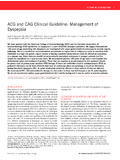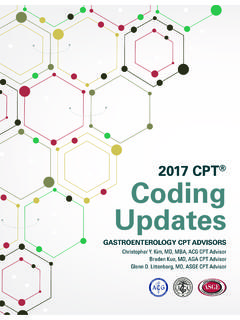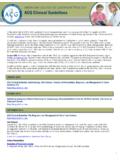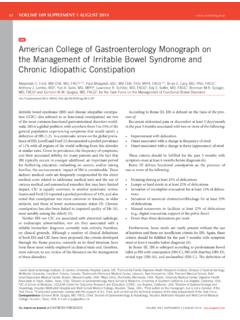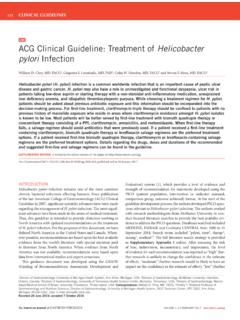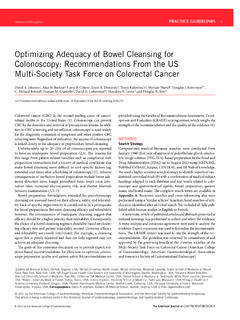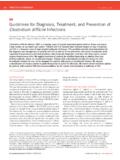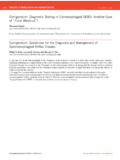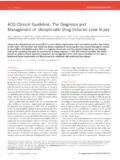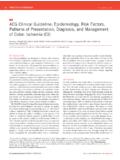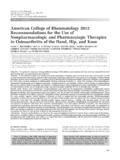Transcription of American College of Gastroenterology Guideline: …
1 Nature publishing group PRACTICE GUIDELINES 1. American College of Gastroenterology Guideline: Management of Acute Pancreatitis Scott Tenner, MD, MPH, FACG1, John Baillie, MB, ChB, FRCP, FACG2, John DeWitt, MD, FACG3 and Santhi Swaroop Vege, MD, FACG4. This guideline presents recommendations for the management of patients with acute pancreatitis (AP). During the past decade, there have been new understandings and developments in the diagnosis, etiology, and early and late management of the disease. As the diagnosis of AP is most often established by clinical symptoms and laboratory testing, contrast-enhanced computed tomography (CECT) and/or magnetic resonance imaging (MRI) of the pancreas should be reserved for patients in whom the diagnosis is unclear or who fail to improve clinically. Hemodynamic status should be assessed immediately upon presentation and resuscitative measures begun as needed.
2 Patients with organ failure and/or the systemic inflammatory response syndrome (SIRS) should be admitted to an intensive care unit or intermediary care setting whenever possible. Aggressive hydration should be provided to all patients, unless cardiovascular and/or renal comorbidites preclude it. Early aggressive intravenous hydration is most beneficial within the first 12 24 h, and may have little benefit beyond. Patients with AP and concurrent acute cholangitis should undergo endoscopic retrograde cholangiopancreatography (ERCP) within 24 h of admission. Pancreatic duct stents and/or postprocedure rectal nonsteroidal anti-inflammatory drug (NSAID). suppositories should be utilized to lower the risk of severe post-ERCP pancreatitis in high-risk patients. Routine use of prophylactic antibiotics in patients with severe AP and/or sterile necrosis is not recommended. In patients with infected necrosis, antibiotics known to penetrate pancreatic necrosis may be useful in delaying intervention, thus decreasing morbidity and mortality.
3 In mild AP, oral feedings can be started immediately if there is no nausea and vomiting. In severe AP, enteral nutrition is recommended to prevent infectious complications, whereas parenteral nutrition should be avoided. Asymptomatic pancreatic and/or extrapancreatic necrosis and/or pseudocysts do not warrant intervention regardless of size, location, and/or extension. In stable patients with infected necrosis, surgical, radiologic, and/or endoscopic drainage should be delayed, preferably for 4 weeks, to allow the development of a wall around the necrosis. Am J Gastroenterol advance online publication, 30 July 2013; Acute pancreatitis (AP) is one of the most common diseases There have been important changes in the definitions and of the gastrointestinal tract, leading to tremendous emotion- classification of AP since the Atlanta classification from 1992. al, physical, and financial human burden (1,2).
4 In the United (5). During the past decade, several limitations have been rec- States, in 2009, AP was the most common Gastroenterology ognized that led to a working group and web-based consensus discharge diagnosis with a cost of billion dollars (2). revision (6). Two distinct phases of AP have now been identified: Recent studies show the incidence of AP varies between (i) early (within 1 week), characterized by the systemic inflam- and cases per 100,000 worldwide (3,4). An increase in matory response syndrome (SIRS) and/or organ failure; and the annual incidence for AP has been observed in most recent (ii) late ( > 1 week), characterized by local complications. It is studies. Epidemiologic review data from the 1988 to 2003 critical to recognize the paramount importance of organ failure National Hospital Discharge Survey showed that hospital in determining disease severity. Local complications are defined admissions for AP increased from 40 per 100,000 in 1998 to as peripancreatic fluid collections, pancreatic and peripancreatic 70 per 100,000 in 2002.
5 Although the case fatality rate for AP necrosis (sterile or infected), pseudocysts, and walled-off necro- has decreased over time, the overall population mortality rate sis (sterile or infected). Isolated extrapancreatic necrosis is for AP has remained unchanged (1). also included under the term necrotizing pancreatitis; although 1. State University of New York, Downstate Medical Center, Brooklyn, New York, USA; 2 Carteret Medical Group, Morehead City, North Carolina, USA; 3 Indiana University Medical Center, Indianapolis, Indiana, USA; 4 Mayo Clinic, Rochester, Minnesota, USA. Correspondence: Santhi Swaroop Vege, MD, FACG, Division of Gastroenterology , Mayo Clinic, 200 First Street SW, Rochester, Minnesota 55905, USA. E-mail: Received 23 December 2012; accepted 18 June 2013. 2013 by the American College of Gastroenterology The American Journal of Gastroenterology . 2 Tenner et al.
6 Table 1. GRADE system of quality of evidence and strength of (iii) characteristic findings from abdominal imaging (strong recommendation recommendation, moderate quality of evidence). 2. Contrast-enhanced computed tomography (CECT) and/or High Further research is very unlikely to change our confidence in the estimate of effect. magnetic resonance imaging (MRI) of the pancreas should Moderate Further research is likely to have an important impact on be reserved for patients in whom the diagnosis is unclear or our confidence in the estimate of effect and may change the who fail to improve clinically within the first 48 72 h after estimate. hospital admission or to evaluate complications (strong Low Further research is very likely to have an important impact on recommendation, low quality of evidence). our confidence in the estimate of effect and is likely to change the estimate.
7 Very low Any estimate of the effect is very uncertain. DIAGNOSIS: CLINICAL PRESENTATION. Patients with AP typically present with epigastric or left upper quadrant pain. The pain is usually described as constant with radiation to the back, chest, or flanks, but this description is non- outcomes like persistent organ failure, infected necrosis, and mor- specific. The intensity of the pain is usually severe, but can be vari- tality of this entity are more often seen when compared to inter- able. The intensity and location of the pain do not correlate with stitial pancreatitis, these complications are more commonly seen severity. Pain described as dull, colicky, or located in the lower in patients with pancreatic parenchymal necrosis (7). There is now abdominal region is not consistent with AP and suggests an alter- a third intermediate grade of severity, moderately severe AP, that native etiology.
8 Abdominal imaging may be helpful to determine is characterized by local complications in the absence of persistent the diagnosis of AP in patients with atypical presentations. organ failure. Patients with moderately severe AP may have tran- sient organ failure, lasting < 48 h. Moderately severe AP may also exacerbate underlying comorbid disease but is associated with a DIAGNOSIS: LABORATORY PARAMETERS. low mortality. Severe AP is now defined entirely on the presence of Because of limitations in sensitivity, specificity, and positive and persistent organ failure (defined by a modified Marshall Score) (8). negative predictive value, serum amylase alone cannot be used We first discuss the diagnosis, etiology, and severity of AP. We reliably for the diagnosis of AP and serum lipase is preferred. then focus on the early medical management of AP followed by a Serum amylase in AP patients generally rises within a few hours discussion of the management of complicated disease, most nota- after the onset of symptoms and returns to normal values within bly pancreatic necrosis.
9 Early management focuses on advance- 3 5 days; however, it may remain within the normal range on ments in our understanding of aggressive intravenous hydration, admission in as many as one-fifth of patients (12,13). Compared which when applied early appears to decrease morbidity and with lipase, serum amylase returns more quickly to values below mortality (9,10). The evolving issues of antibiotics, nutrition, and the upper limit of normal. Serum amylase concentrations may endoscopic, radiologic, surgical, and other minimally invasive be normal in alcohol-induced AP and hypertriglyceridemia. interventions will be addressed. Serum amylase concentrations might be high in the absence A search of MEDLINE via the OVID interface using the MeSH of AP in macroamylasaemia (a syndrome characterized by term acute pancreatitis limited to clinical trials, reviews, guide- the formation of large molecular complexes between amylase lines, and meta-analysis for the years 1966 2012 was undertaken and abnormal immunoglobulins), in patients with decreased without language restriction, as well as a review of clinical trials glomerular filtration rate, in diseases of the salivary glands, and reviews known to the authors were performed for the prepara- and in extrapancreatic abdominal diseases associated with tion of this document.
10 The GRADE system was used to grade the inflammation, including acute appendicitis, cholecystitis, intes- strength of recommendations and the quality of evidence (11). An tinal obstruction or ischemia, peptic ulcer, and gynecological explanation of the quality of evidence and strength of the recom- diseases. mendations is shown in Table 1. Each section of the document Serum lipase appears to be more specific and remains ele- presents the key recommendations related to the section topic, vated longer than amylase after disease presentation. Despite followed by a summary of the supporting evidence. A summary of recommendations of previous investigators (14) and guidelines recommendations is provided in Table 2. for the management of AP (15) that emphasize the advantage of serum lipase, similar problems with the predictive value remain in certain patient populations, including the existence DIAGNOSIS of macrolipasemia.
